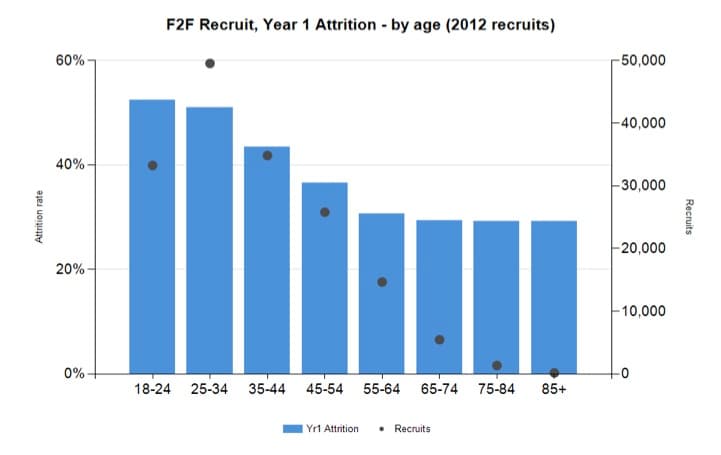You just gotta love older people
- Written by
- Sean Triner
- Added
- March 24, 2016

If you are a fundraiser, you just gotta love older people. Fundraisers, on average are pretty young. Donors, on average are pretty old. So we have an interesting gap to overcome in connecting these fundraisers and donors.
By old I mean around 70.
One solution is to try and make younger people donate, like older people do. Many charities have a strategy to ‘get younger donors’. This is laudable and the correct thing to do – after they have got as many older people as donors as they can.

Not long ago, the best way to get young people to donate was to wait 30 years. This is still mostly the case, with only face to face cracking the trend on a strategic scale and online giving scratching at the surface. But even in face to face the older donors are better.
Online giving is beginning to have an impact, with more 50 year olds (i.e. younger people) giving online every year. Charities like Soi Dog (referenced later) have cracked the social media holy grail and actually got Facebook to work. But overall, online solicitation of donors is still a minor part of all giving.
The chart shows the small number of online regular givers and one-off (cash) donors acquired by 60 charities. These organisations raised over $1bn in Australia in 2013. Note these charities give a statistically valid sample of total individual regular and one-off giving.

There are three reasons charity staff want young people to give:
1. They are young fundraisers and it is just how they think.
2. Their database is ageing and dying and they are worried about it declining.
3. They are worried that if we don’t get them giving now, they won’t give when they get older.
The first has no logic or data-based reason to pursue younger people.
The second is relatively good news. Ageing databases give more, 70 year olds in New Zealand, Australia and the UK have still got 15-20 years of giving left. And they are good bequest prospects.
The third is a constant terror that has been with us for generations. Historically, every single generation gave less than their older peers. Until they became older and then they gave more: every time, so far.
Past performance is the best indicator of future performance. But we can’t be sure that this will be the case in the future so we should be vigilant. We do have some cool, positive indicators though, for example, the millions of 40 year olds now supporting charity through regular gifts solicited on the streets and door to door. Hopefully these guys will be more generous in 2039 than current 65 year olds are right now.
Yes, we do want young people to give – but the responsible fundraiser absolutely must focus first efforts on older people. Exceptions would be using the now proven face to face, research and development, or, in some cases, a unique position.
One example of this unique position is the aforementioned Soi Dog. Soi Dog is a Thai charity that fundraises internationally. Soi Dog simply can’t market locally like US-, UK- or Aussie-based charities so they have to fundraise online. And they are bloody good at it. Better, in fact, than any New Zealand or Australian charity at acquiring donors through Facebook. But Soi Dog raise less money through their brilliant, world-beating global online fundraising than the Lost Dogs’ Home does through direct mail and bequests in one state of Australia. Soi Dog and the Lost Dogs’ Home do essentially the same thing in Phuket and Melbourne respectively.
I will be blunt here – in strategic volumes:
- Older people are usually less expensive to get a first gift from in the first place.
- Older people are much more likely to give a second gift.
- Older people are less likely to cancel regular gifts.
- Older people give more.
- Younger people are less likely to die and leave a bequest within a budgetable time period.
The income in the chart is the average household personal income for people at that age.

This is not to suggest you shouldn’t ‘do online’ – an area usually associated with younger donors. Although online solicited donations are still not strategically significant as an average across charities in Australia and New Zealand, there are a few charities that are doing very well.
And guess what – the older donors picked up online will be better than the younger ones!

















